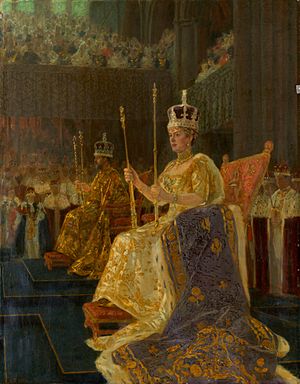List of British royal consorts facts for kids
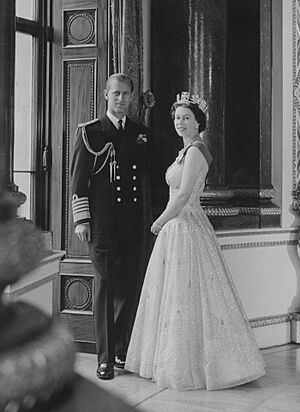
A royal consort is the husband or wife of a reigning king or queen. These consorts in Britain do not have official government power. However, many have been very important and have helped the monarch with their duties. Since Britain joined together in 1707, there have been 11 royal consorts. Eight of them were women and three were men.
Prince Philip, the husband of Queen Elizabeth II, was the longest-serving consort. He was also the oldest ever. He served for almost 70 years until he passed away in 2021. When Charles III became king on September 8, 2022, his wife Camilla became the queen consort.
Contents
History of British Royal Consorts
Since England and Scotland joined together in 1707, there have been eleven consorts of the British monarch. Queens between 1727 and 1814 were also Electress of Hanover. This was because their husbands were Electors of Hanover. From 1814 to 1837, queens were also Queen of Hanover. Their husbands were kings of Hanover.
The connection with Hanover ended in 1837. This happened when Queen Victoria became queen. Hanover's laws meant a woman could not inherit the title if there was a male heir. In the United Kingdom, a male only took priority over his own sisters. This rule changed with the Succession to the Crown Act 2013. In 1866, Hanover became part of Prussia.
Not all wives of monarchs have become consorts. Some died before their husbands became king. Others divorced before their husbands took the throne. Some married after their husbands gave up the throne. Examples include Sophia Dorothea of Celle, who was the wife of the future King George I. Another was Wallis Warfield, wife of the former King Edward VIII. Also, Lady Diana Spencer, wife of the future King Charles III, was not a consort.
Only George I and Edward VIII were unmarried during their time as king.
Since 1937, the monarch's consort can become a counsellors of state. The first four people in the line to the throne who are over 21 can also be appointed. Counsellors of state help with some of the monarch's duties. They do this when the monarch is out of the country. They also help if the monarch cannot perform their duties for a short time.
Royal Consort Titles and Styles
The wife of a reigning king is called "Her Majesty The Queen." This is during her husband's reign. After her husband's death, she is called "Her Majesty Queen [first name]." People refer to her as "Her Majesty" and speak to her as "Your Majesty."
Since her coronation in 2023, Camilla, the current royal consort, is also called "Her Majesty The Queen." This follows tradition. At first, she was called "Her Majesty The Queen Consort." This was to show she was different from Queen Elizabeth II. Queen Elizabeth II had recently passed away. As a queen regnant (a queen who rules), she was also called "Her Majesty The Queen."
Male Consorts: Husbands of Queens
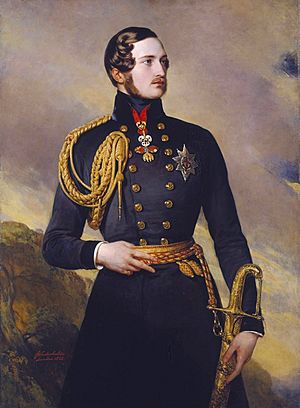
The husband of a reigning queen does not share her royal title. The three husbands who have been consorts have had different titles.
- Prince George of Denmark, husband of Queen Anne, did not get an official title as consort. His princely title was Danish. He was made the Duke of Cumberland in 1689. This was several years before his wife became queen in 1702.
- Prince Albert of Saxe-Coburg and Gotha, husband of Queen Victoria, did not take a British noble title. He was given the title of Prince Consort in 1857. He is the only male consort in the UK to have held this title. Queen Victoria wanted to call him King Consort, but the government did not allow it.
- Prince Philip of Greece and Denmark, husband of Queen Elizabeth II, was made Duke of Edinburgh in 1947. This was five years before his wife became queen. He was made a prince of the United Kingdom in 1957.
Coronation Ceremony for Consorts
Queens consort take part in the coronation ceremony. They go through many of the same traditions as the monarch. Queens traditionally wear fancy robes. They walk in the procession under a special canopy. They are also anointed with holy oil and crowned. Traditionally, male consorts are not crowned or anointed during the ceremony.
There was an unusual case with Caroline of Brunswick-Wolfenbüttel. She had separated from her husband, George IV, before he became king. She became queen consort by law. However, she had no place at court. She was not allowed to attend his coronation and was not crowned.
Royal Regalia: Crowns and Sceptres
The oldest surviving crown for a consort was made in 1685 for Mary of Modena. In the early 1900s, new crowns were made for each queen consort. However, Queen Camilla did not have a new crown made for her coronation in 2023. She was crowned using the 1911 Crown of Queen Mary.
The Queen Consort's Ring was first made for the coronation of Queen Adelaide in 1831. Queens consort have used it ever since.
The Queen Consort's Rod with Dove stands for 'fairness and kindness'. The dove, with its folded wings, is a symbol of the Holy Ghost. The Queen Consort's Sceptre with Cross was first made for Mary of Modena's coronation in 1685. It has clear rock crystals on it.
List of British Royal Consorts
| Picture | Name | Arms | Birth | Marriage | Became consort | Coronation | Ceased to be consort | Death | Grave site | Tenure | Spouse |
|---|---|---|---|---|---|---|---|---|---|---|---|
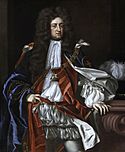 |
George of Denmark and Norway |  |
2 April 1653
Son of Frederick III of Denmark and Norway and Sophie Amalie of Brunswick-Calenberg |
28 July 1683 | 1 May 1707 Creation of the Kingdom of Great Britain; became consort to the monarch of England and Scotland upon spouse's accession 8 March 1702 |
Not crowned | 28 October 1708 55 years, 209 days |
Westminster Abbey | 1 year, 180 days | Anne | |
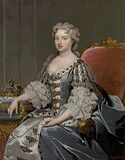 |
Wilhelmina Charlotte Caroline of Brandenburg-Ansbach |  |
1 March 1683
Daughter of John Frederick, Margrave of Brandenburg-Ansbach and Eleonore Erdmuthe of Saxe-Eisenach |
22 August 1705 | 11 June 1727 Spouse's accession |
11 October 1727 | 20 November 1737 54 years, 172 days |
10 years, 162 days | George II | ||
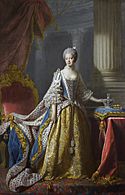 |
Sophia Charlotte of Mecklenburg-Strelitz |    |
19 May 1744
Daughter of Duke Charles Louis Frederick of Mecklenburg-Strelitz, Prince of Mirow and Elisabeth Albertine of Saxe-Hildburghausen |
8 September 1761 Marriage to the monarch |
22 September 1761 | 17 November 1818 74 years, 126 days |
St George's Chapel, Windsor Castle | 57 years, 70 days | George III | ||
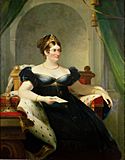 |
Caroline Amelia Elizabeth of Brunswick-Wolfenbüttel |  |
17 May 1768
Daughter of Charles William Ferdinand, Duke of Brunswick-Wolfenbüttel and Augusta of Great Britain |
8 April 1795 | 29 January 1820 Spouse's accession |
Not crowned | 7 August 1821 53 years, 72 days |
Brunswick Cathedral | 1 year, 190 days | George IV | |
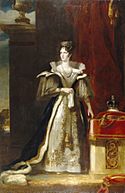 |
Adelaide Amelia Louise Theresa Caroline of Saxe-Meiningen |  |
13 August 1792
Daughter of Georg I, Duke of Saxe-Meiningen and Louise Eleanore of Hohenlohe-Langenburg |
13 July 1818 | 26 June 1830 Spouse's accession |
8 September 1831 | 20 June 1837 Spouse's death |
2 December 1849 56 years, 311 days |
St George's Chapel, Windsor Castle | 6 years, 359 days | William IV |
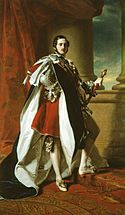 |
Franz August Karl Albert Emanuel of Saxe-Coburg and Gotha | 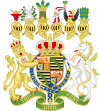 |
26 August 1819
Son of Ernest I, Duke of Saxe-Coburg and Gotha and Louise of Saxe-Gotha-Altenburg |
10 February 1840 Marriage to the monarch |
Not crowned | 14 December 1861 42 years, 110 days |
St George's Chapel, Windsor Castle, then Frogmore Royal Mausoleum | 21 years, 307 days | Victoria | ||
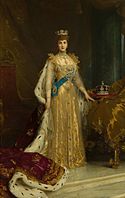 |
Alexandra Caroline Marie Charlotte Louise Julia of Denmark |  |
1 December 1844
Daughter of Christian IX of Denmark and Louise of Hesse-Kassel |
10 March 1863 | 22 January 1901 Spouse's accession |
9 August 1902 | 6 May 1910 Spouse's death |
20 November 1925 80 years, 354 days |
St George's Chapel, Windsor Castle | 9 years, 104 days | Edward VII |
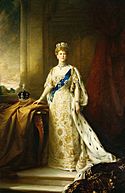 |
Victoria Mary Louise Olga Pauline Claudine Agnes of Teck |  |
26 May 1867
Daughter of Francis, Duke of Teck and Princess Mary Adelaide of Cambridge |
6 July 1893 | 6 May 1910 Spouse's accession |
22 June 1911 | 20 January 1936 Spouse's death |
24 March 1953 85 years, 302 days |
25 years, 259 days | George V | |
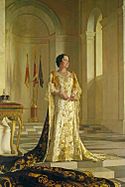 |
Elizabeth Angela Marguerite Bowes-Lyon |  |
4 August 1900
Daughter of Claude Bowes-Lyon, 14th Earl of Strathmore and Kinghorne and Cecilia Cavendish-Bentinck |
26 April 1923 | 11 December 1936 Spouse's accession |
12 May 1937 | 6 February 1952 Spouse's death |
30 March 2002 101 years, 238 days |
15 years, 57 days | George VI | |
 |
Philip of Greece and Denmark |  |
10 June 1921
Son of Prince Andrew of Greece and Denmark and Princess Alice of Battenberg |
20 November 1947 | 6 February 1952 Spouse's accession |
Not crowned | 9 April 2021 99 years, 303 days |
69 years, 62 days | Elizabeth II | ||
 |
Camilla Rosemary Shand |  |
17 July 1947
Daughter of Bruce Shand and The Honourable Rosalind Cubitt |
9 April 2005 | 8 September 2022 Spouse's accession |
6 May 2023 | Incumbent Age: 78 years, 149 days |
Living | 3 years, 97 days | Charles III | |
Timeline of British Royal Consorts

See also
 In Spanish: Anexo:Consortes británicos para niños
In Spanish: Anexo:Consortes británicos para niños


